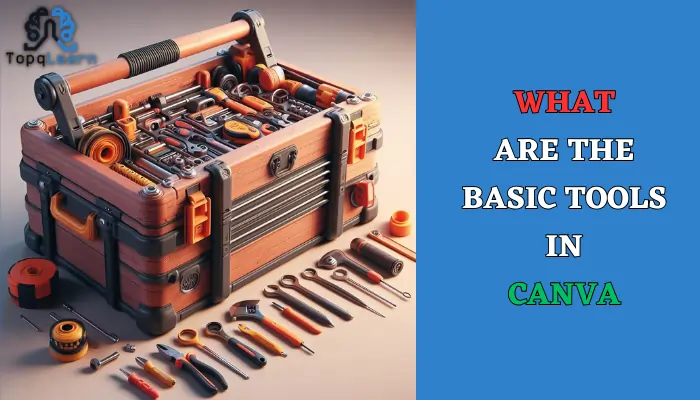Canva is a popular graphic design platform that makes it easy for anyone to create stunning designs. With its simple drag-and-drop interface and extensive library of templates, images, fonts, and more, Canva simplifies graphic design for beginners and professionals alike.
In this article, we’ll outline the basic tools you need to know to start designing in Canva.
The Canvas
The canvas is the main working area in Canva where you arrange your elements to create your design. You can adjust the canvas size for different formats like social media posts, presentations, posters, and more.
Anything you place on the canvas can be moved, resized, rotated, or deleted as needed.
Text Tools
Canva offers a variety of text tools to add words, headings, subtitles, quotes and more to your designs. You can customize the font, color, size and alignment of text. The text can be placed anywhere on the canvas and edited or moved around at any time.
Shapes
The shapes tool provides access to simple lines, geometric shapes, banners and other pre-designed graphic elements. You can resize, rotate and rearrange shapes on the canvas to create icons, diagrams illustrations and other effects.
Images
Canva has an extensive stock photo library with over 1 million curated images you can use in your designs. You can search for photos by keyword or browse categories. Images can be cropped, resized, rotated and edited. Your own images can also be uploaded.
Elements
The elements toolbar houses more complex design assets like charts, maps, illustrations and more. These visuals are already pre-designed so they’re easy to drag onto the canvas. The styles and colors can be customized.
Uploads
In addition to stock photos, you can upload your own image, video, and audio files to use in your Canva designs. Supported file types include JPG, PNG, MP4, MOV and MP3. This allows you to fully customize your creations.
Folders
Folders allow you to organize your uploaded assets like brand images, logos, and fonts for quick access. You can create separate folders for different projects or clients to keep your assets organized.
Grids
Canva offers grid overlays like the Rule of Thirds to help with layout and alignment. Grids make it easier to organize elements and follow design principles.
Frames
Add frames around images, shapes or other elements to give them a border. Choose from various colors, patterns and line styles.
Backgrounds
Customize the canvas background with colors, gradients or photos. This lets you create branded designs that match a company’s visual identity.
Effects
The effects tools let you apply filters like blur, saturate, brighten, contrast, vintage and more to images or shapes to enhance their visual appeal.
Shadows
Add depth and dimension to text, images and other elements with drop shadows. Customize the angle, distance, blur and color.
Transparency
Adjust the opacity of any element to create see-through or layered effects. Lowering transparency is great for overlays.
Layers
Stack elements in layers to have control over placement and overlap. Layers allow for more complex designs with foreground and background objects.
Flip
Quickly flip elements horizontally or vertically to create variation and visual interest. This is useful for symmetrical designs.
Align
Align text, shapes or image centrally or to the left, right, top or bottom with the align options. This helps organize designs clearly.
Resize
Easily resize any element by dragging the corners or entering exact dimensions. Maintain proportion by holding shift when resizing.
Stickers
Fun icons, shapes and illustrations that can be added for visual interest and customization.
Grid Snap
Allows objects to snap to the grid for easy alignment. Can be enabled/disabled.
Rulers
Horizontal and vertical rulers on the edges of the canvas help guide layout and measurement.
Zoom
Zoom in or out on the canvas for a more detailed or big picture view of your design.
Animations
Add animations like fades or bouncing entrances to images, text and other elements.
Filters
Stylize your designs with filters like vintage, chromatic aberration, pixelate and more.
Blur
Blur specific areas of images or the entire background to add depth.
Crop
Cropping allows you to cut out only the part of an image you need.
Eraser
Removes parts of an image or shape. Useful for creating cutouts or custom shapes.
Opacity
Makes any object transparent so layers below show through. Great for overlays.
Conclusion
These basic tools – the canvas, text, shapes, images, elements, uploads and folders – give you everything you need to create stunning designs in Canva. With a little practice, anyone can learn to generate social media posts, ads, posters, infographics, presentations and much more. Canva’s simple interface makes graphic design accessible and enjoyable for all.
FAQ
What’s the easiest way to learn Canva?
Take advantage of Canva’s tutorials and free online courses to learn the basics. Trying things out and experimenting on simple designs is also a great way to get familiar with Canva.
Does Canva have pre-designed templates?
Yes, Canva offers thousands of professionally designed templates for presentations, social media posts, resumes, YouTube thumbnails, infographics and more. You can customize any template to fit your needs.
How much does Canva cost?
The basic version of Canva is free. Canva for Enterprise and Canva Pro offer additional features and elements for a monthly subscription fee. But the free version is very capable for most non-professionals.
What file formats does Canva use?
You can download your Canva designs in standard formats like JPG, PNG, PDF and MP4. For editable documents, Canva uses the proprietary CDR, CDD and CPD formats.
Can I use my own photos and videos in Canva?
Yes, you can upload your own image, video, and audio files to customize your Canva designs. Supported file types include JPG, PNG, MP4, MOV and MP3.

